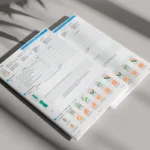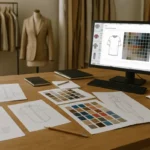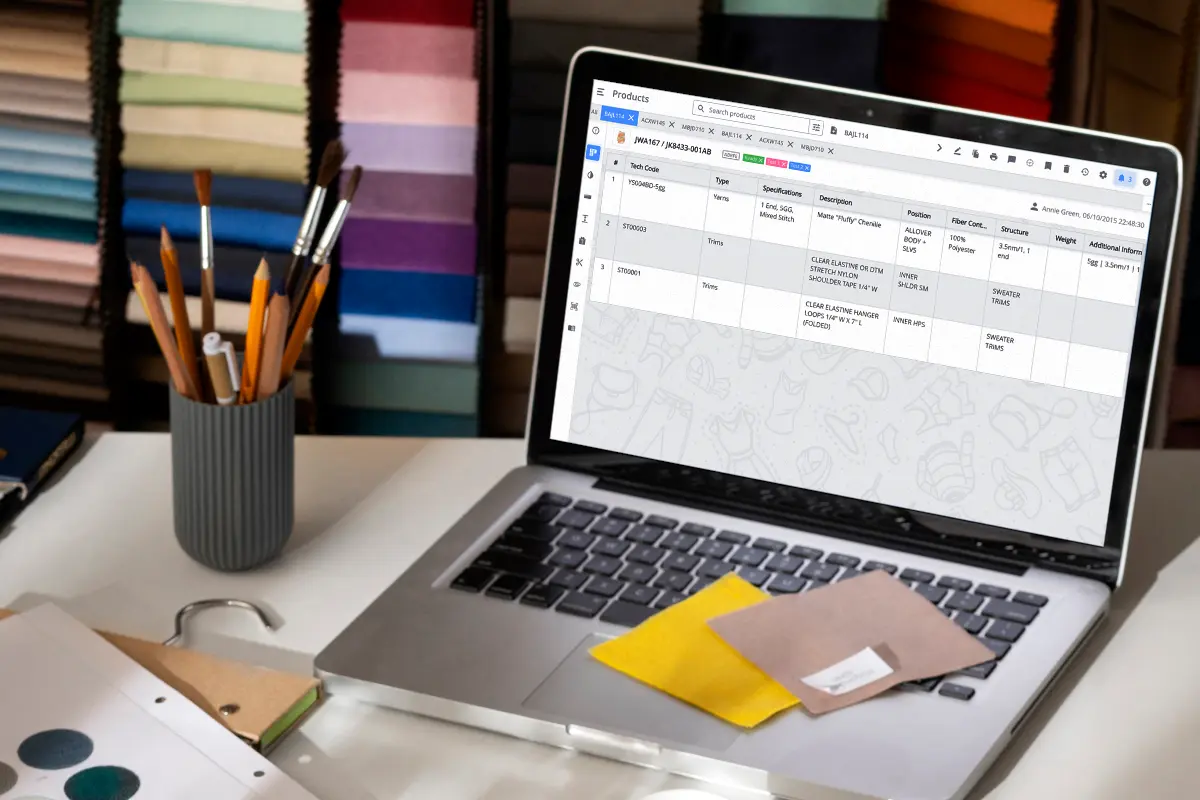
Bill of material
In the fashion industry, a well-organized Bill of Material (BOM) is crucial for efficient production. The BOM outlines every component required to manufacture a garment, serving as the blueprint for the entire production process. By integrating BOM data with fashion PLM software (Product Lifecycle Management), apparel brands can simplify operations, minimize errors, and optimize the manufacturing process.
This guide dives into the fundamentals of BOMs in fashion, their role in apparel production, and how BOM management software transforms business processes.
Introduction to the Apparel Industry
The apparel industry is a complex and dynamic sector that involves the design, production, and distribution of clothing and textiles. Characterized by rapid changes in style and seasonality, it is essential for fashion companies to stay ahead of trends and meet ever-evolving consumer demands. Fashion Product Lifecycle Management (PLM) software plays a crucial role in this industry, enabling companies to manage the entire lifecycle of a product, from initial concept to final distribution. By leveraging PLM software, fashion brands can streamline their product development processes, reduce costs, and improve product quality, ensuring they remain competitive in a fast-paced market.
What is a Bill of Material (BOM)?
A Bill of Material lists all the raw materials, components, and instructions needed to create a finished product. A tech pack is often included in a BOM to provide detailed specifications. In fashion, a BOM includes fabrics, trims, accessories, thread, zippers, labels, and even packaging. It defines every raw material and the quantity required to produce a final product.
There are two types of BOMs:
- Single-Level BOMs: These are straightforward, listing only the components for a specific product.
- Multi-Level BOMs: These detail complex products, breaking down each component into sub-components.
For example, a single-level BOM for a t-shirt might list fabric, thread, and a care label, while a multi-level BOM would include specifics like cotton yarn, dyes, and packaging components.
The Importance of Accurate BOMs in Apparel Production
An accurate BOM ensures seamless production planning and eliminates costly mistakes. Here’s how BOMs impact the fashion manufacturing process:
- Material Sourcing: Suppliers need detailed BOMs to source the right materials, ensuring consistency in product designs.
- Inventory Management: Accurate BOMs help manage stock levels, avoiding material shortages or overstocking.
- Production Efficiency: A clear BOM minimizes disruptions in the production process, ensuring that all components required are available.
- Cost Control: Detailed BOMs provide transparency in material costs, helping brands reduce costs and improve profit margins.
Accurate tracking within Production Life Cycle Management (PLM) systems is essential for overseeing manufacturing processes. Without a precise BOM, the risk of production delays, incorrect material orders, and time-consuming corrections increases.
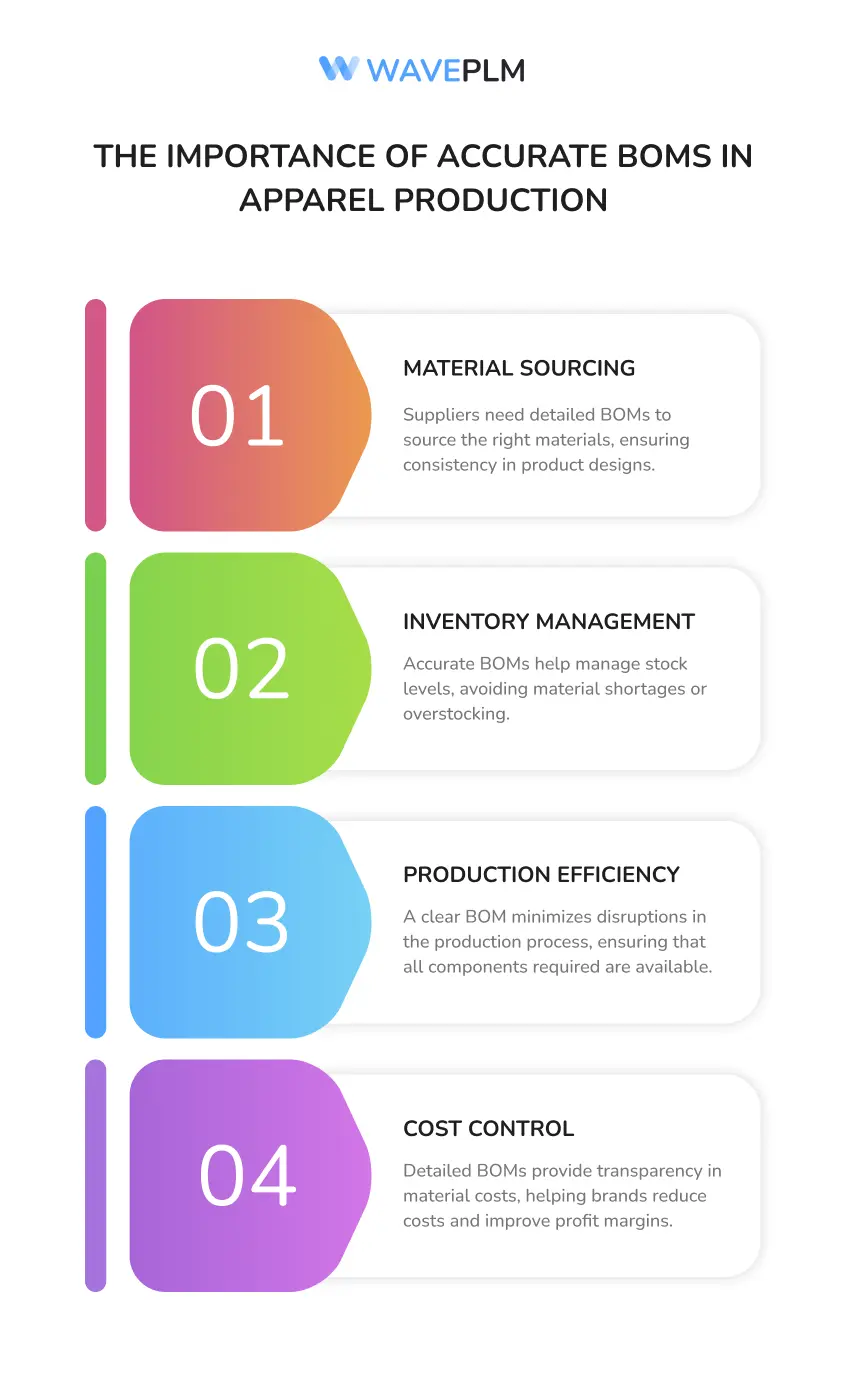
The Importance of Accurate BOMs in Apparel Production
The Role of Design and Production Teams
Design and production teams are the backbone of the apparel industry, working in tandem to create high-quality products that resonate with consumers. The design team is responsible for crafting initial sketches and prototypes, bringing creative visions to life. Meanwhile, the production team oversees the manufacturing process, ensuring that each product is made to specification and meets stringent quality standards. Effective collaboration between these teams is essential, and PLM software facilitates this by providing a centralized platform for communication and data management. With PLM software, design and production teams can work more efficiently, reducing errors and enhancing product quality, ultimately delivering high-quality products that meet consumer demands.
Design Process and BOM Management
The design process in the apparel industry involves several critical stages, from initial concept to final production. A key component of this process is Bill of Materials (BOM) management, which entails creating and managing a comprehensive list of raw materials, components, and instructions required to produce a finished garment. Effective BOM management is crucial for ensuring that products are made correctly and efficiently. PLM software plays a vital role in streamlining this process, allowing fashion companies to create accurate BOMs, manage material costs, and ensure that production teams have access to the necessary information to produce high-quality products. By integrating BOM management into the design process, fashion companies can enhance their operational efficiency and product quality.
Challenges in BOM Management
Managing BOMs manually or with outdated tools often leads to inefficiencies. Common challenges include:
- Data Inaccuracy: Mistakes in raw material specifications or quantities disrupt production.
- Version Control Issues: Inconsistent BOM versions create confusion between design and manufacturing teams.
- Limited Scalability: As collections grow, manually updating BOMs becomes increasingly difficult.
- Disconnected Systems: When BOMs aren’t integrated with other systems like inventory or supply chain management, data silos hinder efficiency.
- Manual Data Entry: Inefficiencies caused by repetitive tasks associated with manual data entry prevent users from focusing on growing their brand.
These challenges make it clear why BOM management software is essential for modern fashion brands.
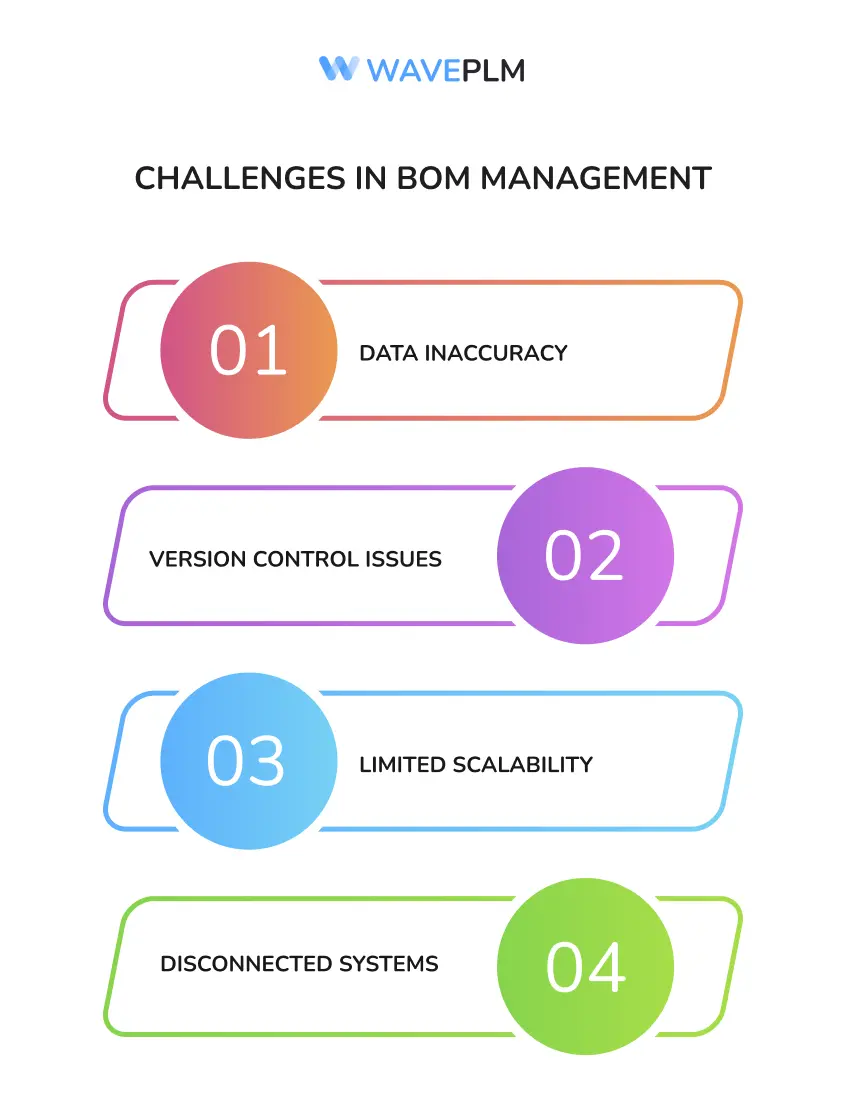
Challenges in BOM Management
How BOM Management Enhances Apparel Production
Bill of material management software is designed to streamline the creation, organization, and management of BOMs. It helps in organizing and tracking different production stages, ensuring each phase from conception to retirement is effectively managed. Some PLM systems like Wave PLM have built-in software, brands can connect BOM data with product designs, inventory, and production schedules.
Key Benefits of BOM Management Software:
- Centralized Data: All BOMs are stored in one system, ensuring consistency across teams and departments.
- Real-Time Updates: Any change in a product structure or material automatically updates across the system, reducing errors.
- Multi-Level BOM Management: Easily manage multi-level BOMs, ensuring clarity even for complex designs.
- Improved Collaboration: Designers, manufacturers, and suppliers work from the same accurate data.
- Time Savings: Automation eliminates the need for manual updates, saving time in the business process.
- Ensure Accurate Tracking: Helps ensure accurate tracking of materials and components, which is crucial for maintaining quality and consistency.
By integrating BOM management tools into a PLM system, brands can also track material usage, monitor inventory levels, and adjust orders as needed.
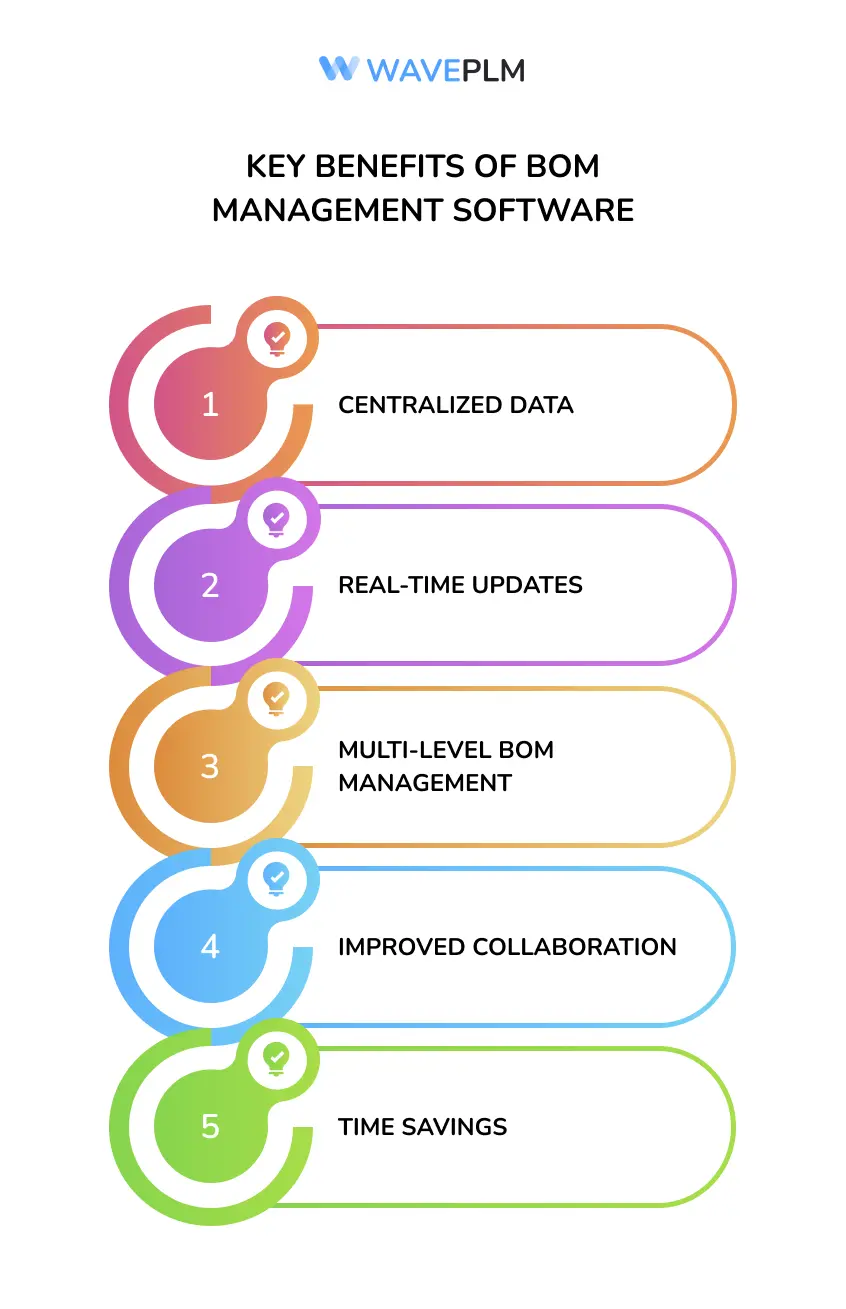
Key Benefits of BOM Management Software
Best Practices for BOM Management
Implementing best practices for BOM management is essential for success in the apparel industry. These practices include creating accurate and detailed BOMs, managing material costs effectively, and ensuring that production teams have access to up-to-date information. PLM software facilitates these best practices by providing a centralized platform for BOM management, enabling fashion companies to create, manage, and share BOMs seamlessly across the organization. Additionally, PLM software helps reduce waste, improve quality, and accelerate time-to-market by ensuring that BOMs are accurate and current. By adhering to these best practices, fashion companies can optimize their production processes and deliver high-quality products efficiently.
PLM Software: The Key to Efficient BOM Management
A PLM system is a centralized platform that manages the entire lifecycle of a product, from design to production, by centralizing product data. When integrated with BOM data, PLM software becomes a powerful tool for optimizing the manufacturing process.
How PLM Software Supports BOM Management:
- Streamlined Product Structure: PLM software organizes BOMs in a logical hierarchy, making it easy to access and update data. This efficient management allows for swift adaptation to trends and handling of complex product variations.
- Unit of Measure Standardization: Ensures all materials are measured consistently, reducing errors in orders and inventory.
- Lifecycle Visibility: Tracks BOM data throughout the product lifecycle, helping teams anticipate material needs at every stage.
- Error Reduction: By centralizing data, PLM software minimizes discrepancies and ensures all teams work with accurate BOMs.
- Integration with Supply Chain: Links BOMs to suppliers and manufacturers, improving supply chain management and reducing lead times.
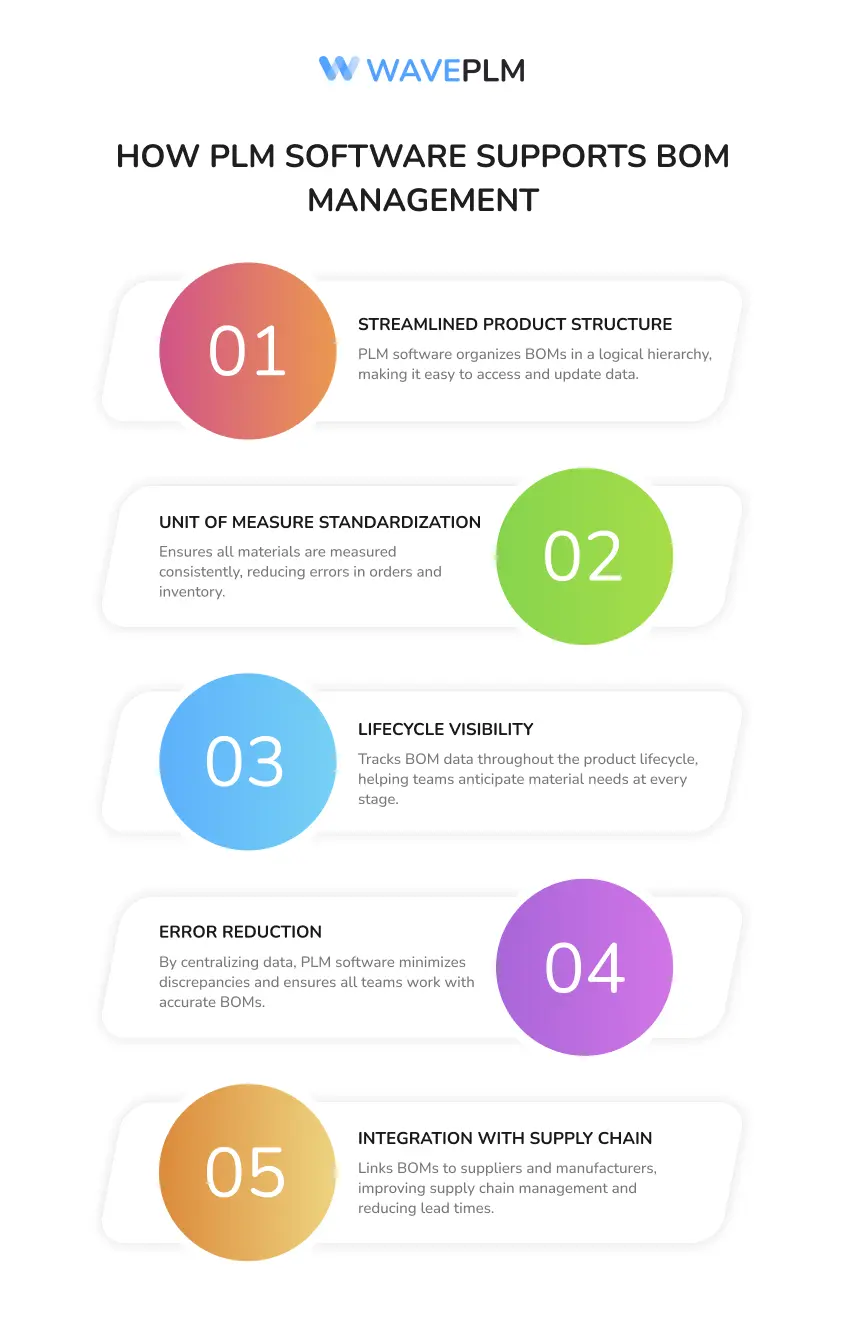
How PLM Software Supports BOM Management
Reducing Waste and Costs with BOM and PLM Integration
Sustainability is a growing focus in fashion, and BOM management software like PLM plays a key role in reducing waste. Integrating BOMs with PLM software helps in reducing production costs by managing financial resources efficiently within the product development process. By accurately tracking materials and production needs, brands can eliminate excess inventory, repurpose unused materials, and optimize the production process.
Additionally, integrating BOMs with PLM software helps brands reduce costs by:
- Preventing over-ordering of materials.
- Avoiding production errors caused by inaccurate BOMs.
- Streamlining communication between design and production teams.
For example, a fashion brand using BOM or PLM fashion software can precisely calculate how much fabric is needed for a new collection, minimizing leftovers and ensuring sustainability.
Real-World Applications of BOM and PLM Integration
Fashion brands around the world in the fashion and apparel industry are leveraging BOM management software and PLM systems to improve operations. Here’s how they’re making an impact:
- Fast Fashion Efficiency: Fast fashion brands rely on automated BOM updates to keep up with rapid design changes and tight timelines.
- Luxury Fashion Precision: High-end brands use detailed BOMs to maintain consistency in quality and design across multiple collections.
- Sustainable Production: Eco-conscious brands use PLM-integrated BOMs to monitor raw material usage and reduce waste throughout the manufacturing process.
These real-world examples highlight the versatility and necessity of integrating BOMs with PLM systems.
Future of BOM Management in the Apparel Industry
The future of BOM management in the apparel industry is poised to be shaped by technological advancements, such as the integration of artificial intelligence and machine learning to optimize BOM creation and management. Additionally, the increasing focus on sustainability and waste reduction is likely to drive the adoption of PLM software and best practices in BOM management. By leveraging PLM software and embracing these advancements, fashion companies can enhance their operational efficiency, reduce costs, and produce high-quality products that meet consumer demands. As the apparel industry continues to evolve, effective BOM management and the use of PLM software will become even more critical, enabling fashion companies to stay ahead of the competition and adapt to changing market needs.
Conclusion: Building a Strong Foundation with BOM and PLM
In the competitive fashion industry, a reliable Bill of Material is more than just a list—it’s the foundation of efficient apparel production. By adopting BOM management software like PLM, brands can streamline their business processes, reduce errors, and support sustainable practices. PLM serves as an all-in-one solution, integrating various functionalities such as Product Information Management (PIM), Digital Asset Management (DAM), and Product Lifecycle Management (PLM), enhancing collaboration and streamlining processes.
Whether you’re managing single-level BOMs or multi-level BOMs, leveraging the right tools ensures accuracy and consistency. In turn, this helps brands deliver high-quality products on time while minimizing waste and costs.
As the fashion landscape evolves, embracing BOM with PLM systems is no longer optional—it’s a necessity for staying ahead in the market. Integrating BOMs with product lifecycle management systems is the key to long-term success for brands seeking to optimise their production process.
Explore how Wave PLM can transform your BOM management and streamline your fashion production process. Contact us today!

